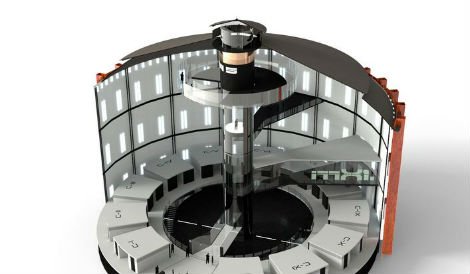The Swedish company behind the James-bond villain-like data center lair Pionen and a modular data center park in Kista, which mimics a space station, has released its latest projects, which this time have been designed to sell excess heat into Sweden’s district heating network.
The data center design team at Bahnhof has teamed up with energy corporation Fortum to design its Data Center for District Heating in the 19th Century 35MW Gasometer and another directly above a main heat pump for metropolitan Stockholm.
Each data center will offer between 10 to 35MW.
In total, two ‘plants’ are being proposed, and already Bahnoff CEO Jon Karlung said interest has been shown by a major American company.
“It’s in its planning stage, but there is substantially serious interest from one of the major giants,” Karlung said.
He said the idea is that the data center design, feeding into Stockholm’s main district heating system, will allow for the end user to eventually be paid for the heat it distributes to the system.
“Why ventilate out the heat, when you can get paid for it?” Karlung said.
He believes the new data center district heating concept can further bring down Power Usage Effectiveness (PUE) levels lower than 1.0.
“We did not have to innovate around the laws of thermodynamics to go far below PUE 1.0,” Karlung said.
Sweden is a world leader in district heating technology, and uses Combined Power and Heating (CPH) plants simultaneously to generate heat and electricity, distributing heat in hot water pipelines to offices and residents.
“Fortum let us construct a data center on top of Europe’s most powerful heat pumps for a district transfer of heat into their system pushing our PUE down to 0.5,” Karlung said.
“Why vent the energy out?”
The proposal for this data center has been called Nimrod, and Bahnfof said it could offer space for 1,000 high-density server racks.
The Nimrod 10MW data center site
It has six cooling units, with a total cooling effect of between 90 and 110MW.
“In addition, there is already a sea water system in place with conventional free cooling, exceeding 100MW, which will be used as a back-up in an economically frugal way,” Bahnof said.
The Gasometer site, which is separate to the one mentioned above, was built in 1893. Karlung plans to create a facility that houses five stories of servers inside, with a PUE of 0.8.
The cylindrical-shaped Gasometer was designed by architect Ferdinand Boberg, with a wood and steel structure with dramatic height that Karlung plans to divide into floors.
The Gasometer: As well as data center space, there will be a second floor reception area, visible on left side. On level 5 is a balcony. On level 6, hovering 26m above the ground level, there is a bar.
Karlung said both locations can easily plug into Stockholm’s Internet Exchange Point, offering 100Gbps fiber connections.

